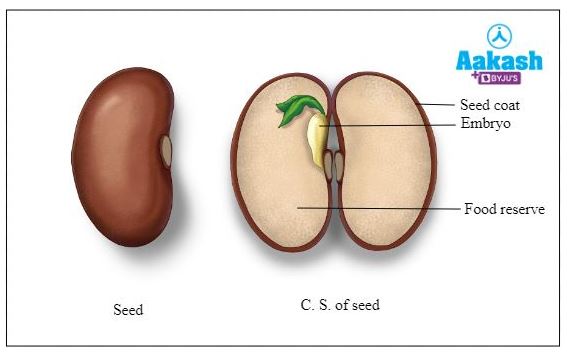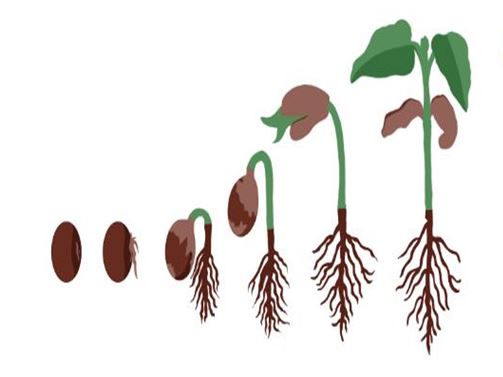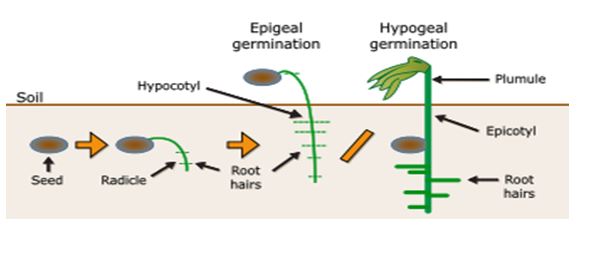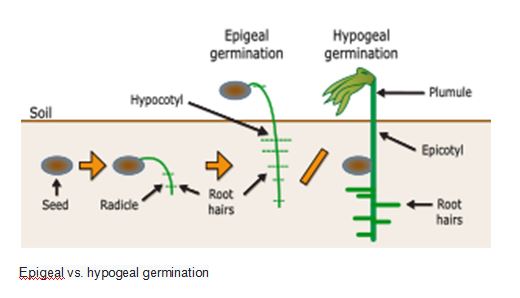Contents for Tables:-
- About Seed
- Seed Germination
- Types of Seed Germination
- Epigeal Germination
- Hypogeal Germination
- Viviparous Germination
- Mechanism of Seed Germination
- Factors affecting Seed Germination
- Conclusion
About Seed

A seed is a mature ovule that comprises an embryo or a miniature undeveloped plant and food reserves, all enclosed within a protective seed coat. Seeds are a way of reproduction for all flowering plants. Every seed is capable of growing into a new plant under proper environmental conditions such as the right temperature, moisture and sunlight.
The seeds of gymnosperms are naked and exposed to the environment, whereas the seeds of flowering plants (angiosperms) form with a protective structure called the fruit. In both cases, the egg inside the ovule is fertilized by a male nucleus through a pollen grain. This process is called pollination in plants. Seeds are primary sources for a variety of foods like wheat, rice, corn,
beans, peas, peanuts and so on. Essentials like cooking oil are created from seeds of flax, cotton, soybean, sunflower, coconut and so on.
Seed germination and dormancy are vital components of seed quality; hence, understanding these processes is essential for a sound seed production system. The two processes are closely interrelated and regulated, both by genetic as well as environmental factors. While dormancy provides an inherent mechanism aimed at the survival of the plant species to withstand adverse external conditions by restricting the mature seed from germinating, the ability of the dehydrated seed to remain viable and produce a vigorous seedling upon hydration under favourable conditions is the key to the survival and perpetuation of the plant species. In addition, quality seed is expected to
result in timely and uniform germination under favorable field conditions after sowing to establish a healthy crop stand. Therefore, in seed technology, dormancy is not considered a desirable trait in the seed lots used for sowing. Thus, to achieve the highest germination percentage, understanding the factors controlling these two interlinked and contrasting processes is vital. In seed testing and seed trade, knowledge of seed germination and dormancy is needed for a reliable assessment of seed quality and its planting value, and to make right decisions. Though much is yet to be understood, the present status of knowledge on these aspects has made significant advances, especially in genetic control, molecular mechanism, and physiological and environmental factors influencing germination and dormancy. The information compiled in this chapter may help the seed technologists in developing new methods for breaking dormancy and testing germination,
Parts of A Seed-
A seed is an important part of a flowering plant. They give rise to a new plant. They may be of different shapes, colours and sizes. They may be round, wrinkled, winged or hairy. They are in a dormant condition until they receive adequate sunlight, water, and soil. The growth of the plant from a seed is known as germination.
A seed has three parts:
- Seed Coat
- Endosperm
- Embryo
Seed Coat
A seed coat protects the internal parts of a seed. The seed coat has two layers. The outer layer is thick and known as the testa. The inner layer is thin and known as tegmen.
A thick seed coat protects the seed from sunlight and water. It prevents the loss of water and entry of parasites within the seeds. The hard seed coats prevent germination during unfavourable environmental conditions.
An opening in the integument of the ovule is known as the micropyle and is visible on some seed coats. The hilum is also visible which is equivalent to the naval in humans where the umbilical cord is attached.
Endosperm
The endosperm contains the nutrients stored in it. It provides nutrients to the seed in the form of starch, carbohydrates and proteins to support the embryo during germination. It is located below the seed coat. The seeds remain viable with the intake of nutrients until germination.
The endosperm may be mealy, continuous or ruminated. An endosperm has a triploid chromosome complement.
In corns and other cereals, endosperm constitutes a major portion of the seed. In seeds like beans, the endosperm is utilized in the embryo development and is absent in the seed. Coconut is the liquid endosperm.
Embryo
The embryo is the most important part of a seed. It is diploid, developed from the fertilized egg. All the cells that need to develop into a mature embryo are present within the embryo.
An embryo comprises the following parts:
- Epicotyl
- Hypocotyl
- Radicle
- Cotyledons
Epicotyl is a small shoot which gives rise to the entire plant shoot system.
The primary root emerges first during germination. It is also known as hypocotyl. It anchors the plant firmly in the soil.
Radicle is a small embryonic root.
The cotyledons provide nourishment to different parts of the embryo. It emerges as a tiny or fleshy leaf from the soil with the seedling during growth. It stores food in the form of starch and protein.
The embryonic leaves are the first to appear above the ground. An embryo develops from a fertilized egg.
Types of Seeds
There are two types of seeds:
- Monocotyledonous seeds
- Dicotyledonous seeds
Monocotyledonous seeds-
Seeds are an essential element of sexual reproduction in plants. It is formed as the end product of sexual reproduction in plants and is exclusive only to angiosperms and gymnosperms. Gymnosperms have no fruits or flowers; hence, their seeds are exposed or “naked”. On the contrary, angiosperms, have matured ovules that develop within the fruits after fertilisation.
Angiosperms are classified as monocots or dicots depending on the number of cotyledons present in the seed. The seed consists of an embryo which is enclosed in a protective outer covering called the seed coat. Some seeds have been documented as having a triploid endosperm. An embryo is composed of three parts- a radicle, an embryo axis, and cotyledons.
Structure of a Monocotyledonous Seed-
- Corn, wheat and rice, are examples of monocot seeds or monocotyledons.
- Embryos of a monocotyledonous seed possess only one large cotyledon called scutellum. The scutellum is generally shield-shaped and is located laterally towards a side of the embryo axis. As in dicotyledons, the embryo axis of monocotyledons possesses a shoot tip, plumule, enclosed
in a sheath called coleoptile and a root tip, radicle, enclosed in coleorhiza. In a
- monocotyledonous seed, the endosperm is covered by a proteinous layer called the aleurone layer.
- The majority of the monocotyledonous seeds are albuminous seeds, i.e., they have thick, swollen endosperms for nourishment. The endosperm is not completely consumed during embryo development, and it is the nourishing tissues in seeds. However, some monocotyledons like orchids show exceptions.
- Other monocot seeds examples include ginger, banana, sorghum, onion, coconut and garlic.
Dicotyledonous seeds
Seeds are an essential element of sexual reproduction in plants. It is formed as the end product of sexual reproduction in plants and is exclusive only to angiosperms and gymnosperms. Gymnosperms have no fruits or flowers; hence, their seeds are exposed or “naked”. On the contrary, angiosperms, have matured ovules that develop within the fruits after fertilisation.
Angiosperms are classified as monocots or dicots depending on the number of cotyledons present in the seed. The seed consists of an embryo which is enclosed in a protective outer covering called the seed coat. Some seeds have
been documented as having a triploid endosperm. An embryo is composed of three parts- a radicle, an embryo axis, and cotyledons.
Structure of a Dicotyledonous Seed
- Peas, almonds and cashews are examples of dicotyledonous or dicot seeds.
- Dicotyledons are also known as dicots. They are the groups into which all the flowering plants or angiosperms were formerly divided. The name dicotyledons refer to the seed having two embryonic cotyledons. There are around 200,000 species of dicotyledons discovered to date.
- In a dicotyledonous seed, the embryo consists of an embryo axis and two cotyledons. Cotyledons generally have a swollen appearance as it acts as a food reserve for the developing seedling. The embryo axis has two ends. The one which forms the shoot tip is called plumule and the portion at the lower end which forms the root tip is called the radicle.
- The whole content is enclosed within a protective cover called the seed coat. The seed coat is made up of an outer layer called testa and an inner layer called tegmen. Moreover, the seed is attached to the fruit through a structure called hilum.
- Other dicot seeds examples include apples, plums and peaches.
What is Seed Germination?

Seed germination may be defined as the fundamental process by which different plant species grow from a single seed into a plant. This process influences both crop yield and quality.
A common example of seed germination is the sprouting of a seedling from a seed of an angiosperm or gymnosperm.
The germination process involves the activation of the dormant seed, leading to the emergence of an embryonic plant. The process is triggered by the imbibition of water, which causes the seed to swell and activates hydrolytic enzymes. These enzymes break down the stored food reserves in the seed, leading to the release of nutrients required for growth. As a result, the embryo expands, and the seed coat breaks, allowing the emergence of the primary root and the shoot. The primary root anchors the seedling to the soil and absorbs water and nutrients, while the shoot develops into the stem and leaves.
The seed germination process begins with the absorption of water by the dry seed. Water uptake activates enzymes that trigger metabolic activity and the
breakdown of food stores within the seed. Digested foods are converted into an active form such as amino acids, fatty acids, and carbohydrates. The
embryo begins to grow and undergoes cellular activity growth, which leads to the emergence of cells and the differentiation of cell components.
Types of Seed Germination
Radical is the first part which comes out during seed germination. It comes out through the micropyle and develops into the root system. This helps the young plant to fix in the soil and to absorb water, nutrients etc. after this the epicotyls and hypocotyls develop and form the shoot system.
According to the order of growth of hypocotyl and epicotyl, there are two types of seed germination and they are as follows:
- Hypogeal germination
- Epigeal germination
Hypogeal germination
The germination of the seeds in which the epicotyl grows first and cotyledons remain underground is called hypogeal germination. The radicle grows deep into the soil and a root system is formed. Then the epicotyl elongates and forms an arch called epicotyl bent. This pushes the plumule upwards out of the soil. Plumule grows fast leaving the cotyledons in the soil. Cotyledons never become green and gradually they dry out and fall.

Hypogeal germination implies that the cotyledons stay below the ground. The epicotyl (part of the stem above the cotyledon) grows, while the hypocotyl (part of the stem below the cotyledon) remains the same in length. In this way, the epicotyl pushes the plumule above the ground.
Normally, the cotyledon is fleshy, and contains many nutrients that are used for germination.
Because the cotyledon stays below the ground, it is much less vulnerable to, for example, night-frost or grazing. The evolutionary strategy is that the plant produces a relatively low number of seeds, but each seed has a bigger chance of surviving.
Plants that show hypogeal germination need relatively little in the way of external nutrients to grow, therefore they are more frequent on nutrient-poor soils. The plants also need less sunlight, so they can be found more often in the middle of forests, where there is much competition to reach the sunlight.
Plants that show hypogeal germination grow relatively slowly, especially in the first phase. In areas that are regularly flooded, they need more time between floodings to develop. On the other hand, they are more resistant when a flooding takes place. After the slower first phase, the plant develops faster than plants that show epigeal germination.
It is possible that within the same genus one species shows hypogeal germination while another species shows epigeal germination. Some genera in which this happens are:
- Phaseolus: the runner bean (Phaseolus coccineus) shows hypogeal germination, whereas the common bean (Phaseolus vulgaris) shows epigeal germination
- Lilium: see Lily seed germination types
- Araucaria: species in the section Araucaria show hypogeal germination, whereas species in the section Eutacta show epigeal germination
Epigeal germination-

Epigeal germination implies that the cotyledons are pushed above ground. The hypocotyl elongates while the epicotyl remains the same in length. In this way, the hypocotyl pushes the cotyledon upward.
Normally, the cotyledon itself contains very few nutrients in plants that show this kind of germination. Instead, the first leaflets are already folded up inside it, and photosynthesis starts to take place in it rather quickly.
Because the cotyledon is positioned above the ground it is much more vulnerable to damage like night-frost or grazing. The evolutionary strategy is that the plant produces a large number of seeds, of which statistically a number survive.
Plants that show epigeal germination need external nutrients rather quickly in order to develop, so they are more frequent on nutrient-rich soils. The plants also need relatively more sunlight for photosynthesis to take place. Therefore they can be found more often in the field, at the border of forests, or as pioneer species.
Plants that show epigeal germination grow relatively fast, especially in the first phase when the leaflets unfold. Because of this, they occur frequently in areas that experience regular flooding, for example at the river borders in the Amazon region. The fast germination enables the plant to develop before the next flooding takes place. After the faster first phase, the plant develops more slowly than plants that show hypogeal germination.
It is possible that within the same genus one species shows epigeal germination while another species shows hypogeal germination. Some genera in which this happens are:
- Phaseolus: the common bean (Phaseolus vulgaris) shows epigeal germination, whereas the runner bean (Phaseolus coccineus) shows hypogeal germination
- Lilium: see Lily seed germination types
- Araucaria: species in the section Eutacta show epigeal germination, whereas species in the section Araucaria show hypogeal germination
